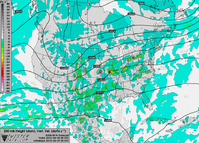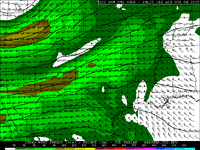adlyons
EF2
Think Ill add my thoughts to the board. Overall my target Wednesday afternoon is along the Northern dryline near Lamont Ok. Leaving Norman Around 2 and getting there by initiation will be no problem.
Positives:
Strong cape
Good shear
Good moisture
Decent convergence and forcing from the dryline and some weak lift from the trough.
Backed Surface winds
Cons:
Uncertainties with cap strength
Trough timing issues
Moisture depth
First lets take a look at Obs. Gulf moisture is there. Buoy and Texas coast sensors indicating low 70's to upper 60's pooled along the coast with southerly winds blowing that north for the next two days. We can expect a decent lowlevel jet the next two night as well with a few smaller waves translating over the region. Obviously that moisture will be there come wednesday. One concern is the depth of that moisture.

While I dont think it is a major concern it is something to pay attention to. /u/Kelton Halbert pointed out the moist layer is a little on the lower side at about 1km thick. That being said observations still show moisture will be in place and likely be of sufficient depth for severe storms. One thing to note is that trajectories are showing the moisture "taking the long way around." This entails the deeper moisture residing over coastal Mexico and SW Texas. It is originating from the lower gulf near the Yucatan and advecting first NW then to the Northeast. Indeed looking at SPC Mesoanlysis and KDRT Observed soundings, the moisture is deep with 850 MB mixing ratios near 12g/kg and 925mb near 16 g/kg.
and advecting first NW then to the Northeast. Indeed looking at SPC Mesoanlysis and KDRT Observed soundings, the moisture is deep with 850 MB mixing ratios near 12g/kg and 925mb near 16 g/kg.

Looking to the west obs right now are showing a dryline through west central Ok with dry air sitting in the Tx Panhandle. The very dry air aloft will be advected over top of the moist air thanks to the SW 700 mb winds. THe EML will be of moderate strength with 700 mb temps this morning in Norman near 15C. Amarillio shows a deep mixed layer with 700 temps near 20C. This is a little bit concerning given how warm that is, but over the next few days this should cool slightly with the impingement of the upper level cold front front on Tuesday night. The lapse rates that will be being advected are nice and steep which if storms get established will mean explosive growth.

Wave timing appeared to be another issues but looking at WV imagery it shows the trough over California ready and waiting to move over the area. Which will provide plentiful shear and some decent lift.

The lift from the trough convergence from the backed Surface winds, and the relatively deep dryline circulation should also work to erode the CINH with probable (70%) initiation somewhere near 21-22Z. Overall Im impressed with the environment. Strong shear and instability working in tandem with good surface features gives me a good feeling about a few isolated storms with tornado potential possibly even a strong one. The initiation sounding from Ponca City is shown below.

As you can see a good environment with several analogues for severe weather. Im very optimistic for a good chase day with a few storms and possibly a few tornadoes. Dont let the idiot masses on Facebook trick you, this is a pretty good looking environment.
Positives:
Strong cape
Good shear
Good moisture
Decent convergence and forcing from the dryline and some weak lift from the trough.
Backed Surface winds
Cons:
Uncertainties with cap strength
Trough timing issues
Moisture depth
First lets take a look at Obs. Gulf moisture is there. Buoy and Texas coast sensors indicating low 70's to upper 60's pooled along the coast with southerly winds blowing that north for the next two days. We can expect a decent lowlevel jet the next two night as well with a few smaller waves translating over the region. Obviously that moisture will be there come wednesday. One concern is the depth of that moisture.

While I dont think it is a major concern it is something to pay attention to. /u/Kelton Halbert pointed out the moist layer is a little on the lower side at about 1km thick. That being said observations still show moisture will be in place and likely be of sufficient depth for severe storms. One thing to note is that trajectories are showing the moisture "taking the long way around." This entails the deeper moisture residing over coastal Mexico and SW Texas. It is originating from the lower gulf near the Yucatan
 and advecting first NW then to the Northeast. Indeed looking at SPC Mesoanlysis and KDRT Observed soundings, the moisture is deep with 850 MB mixing ratios near 12g/kg and 925mb near 16 g/kg.
and advecting first NW then to the Northeast. Indeed looking at SPC Mesoanlysis and KDRT Observed soundings, the moisture is deep with 850 MB mixing ratios near 12g/kg and 925mb near 16 g/kg.
Looking to the west obs right now are showing a dryline through west central Ok with dry air sitting in the Tx Panhandle. The very dry air aloft will be advected over top of the moist air thanks to the SW 700 mb winds. THe EML will be of moderate strength with 700 mb temps this morning in Norman near 15C. Amarillio shows a deep mixed layer with 700 temps near 20C. This is a little bit concerning given how warm that is, but over the next few days this should cool slightly with the impingement of the upper level cold front front on Tuesday night. The lapse rates that will be being advected are nice and steep which if storms get established will mean explosive growth.

Wave timing appeared to be another issues but looking at WV imagery it shows the trough over California ready and waiting to move over the area. Which will provide plentiful shear and some decent lift.

The lift from the trough convergence from the backed Surface winds, and the relatively deep dryline circulation should also work to erode the CINH with probable (70%) initiation somewhere near 21-22Z. Overall Im impressed with the environment. Strong shear and instability working in tandem with good surface features gives me a good feeling about a few isolated storms with tornado potential possibly even a strong one. The initiation sounding from Ponca City is shown below.

As you can see a good environment with several analogues for severe weather. Im very optimistic for a good chase day with a few storms and possibly a few tornadoes. Dont let the idiot masses on Facebook trick you, this is a pretty good looking environment.







